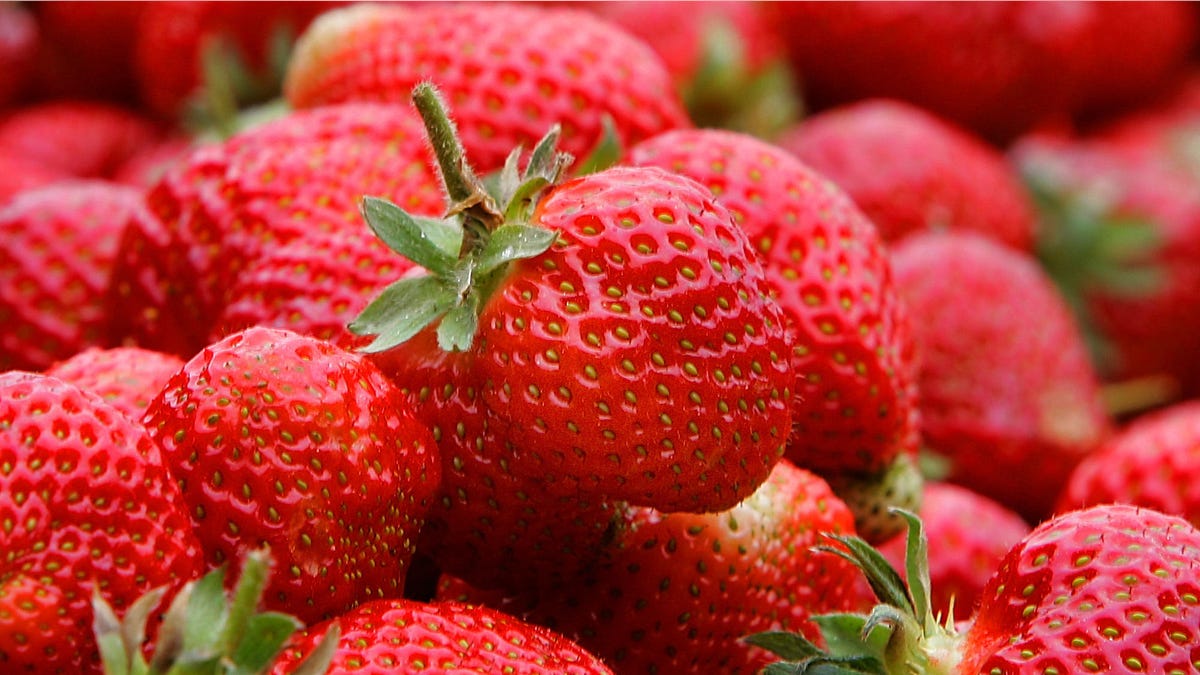
Frisch geerntete Erdbeeren, fotografiert am Dienstag, 23. Mai 2006, auf einem Feld bei Oelde in Nordrhein-Westfalen. Am Dienstag beginnt offiziell der Start der Erdbeersaison in Deutschland. Der Preis fuer ein Schaelchen mit 500 Gramm Erdbeeren soll zwischen 2,30 und 2,80 Euro liegen. (AP Photo/Frank Augstein) --- Fresh strawberrys picked on a field near Oelde, western Germany, are seen on Tuesday, May 23, 2006 at the start of Germany's strawberry harvest season. Some 100,000 tons of strawberrys are expected to be gathered until the end of August. The 500 gram (20 ounces) basket is expected to cost between 2.30 to 2.80 Euro (US$2.95 to 3.59). (AP Photo/Frank Augstein) (AP)
Mice do it, cats do it, dogs do it, and even elephants do it. For some unknown reason, humans and our primate cousins (and, yes, guinea pigs, too) are the only mammals that cannot make their own vitamin C. While the rest of the mammalian world happily and effortlessly takes glucose and turns it into vitamin C, we have been condemned to get ours from food alone.
We actually still have the same gene used by other animals to make vitamin C from glucose (in humans it's called GULOP)— it's just that our version looks genetically like someone cut out parts of it to make a paper napkin snowflake. This means that no matter how hard our DNA and body try, we're not going to be making vitamin C anytime soon. It's also one of the major limitations on our species' ability to travel long distances without a fresh supply from food.
We haven't figured out a way to fix the GULOP gene yet, and so until then you are completely dependent on consuming this key vitamin to shelter you from the damage caused by oxidative stress to your body. Thanks to advanced research studies, we now know that certain genes some people inherited also make them require more vitamin C because these genes don't work as well to prevent oxidative damage that can then harm their tissue and DNA.
So to get your necessary daily dosage of vitamin C daily— 90 milligrams for men, 75 milligrams for women— reach for these surprising foods:
Chili peppers
Just one-half cup of chili peppers will give you 107.8 milligrams of vitamin C, and the extra hot spice is also one of the best spices to help you lose weight, so you'll see the benefits on and off the scale.
Kale
One cup of chopped kale will load you up with 80.4 milligrams of vitamin C, so toss it in your green detox smoothie or turn it into kale chips for a saltier snack.
Papaya
With 95.6 milligrams of vitamin C in a small-size papaya (one of the cleanest fruits in your supermarket), this fruit would make a good addition to a melon salad and can help you reap the nutrient’s immune-system benefits.
Strawberries
Strawberries are not only some of the best foods to tame inflammation, but one cup of this sweet summer fruit will give you just about 84.7 milligrams of vitamin C.
Green bell pepper
The green bell pepper (hint: it's one of the foods you don't need to refrigerate) will also give you a whopping 95.7 milligrams of vitamin C.
Cauliflower
Cauliflower, a shockingly low-calorie food, will deliver 127.7 milligrams of vitamin C but won't cost you many calories. Win, win!
Pineapple
Prepare yourself for 78.9 milligrams of vitamin C with just one cup of pineapple! So go ahead— throw the fruit on the grill and enjoy the health benefits.
Kiwi
Put it in a skin- and nails-boosting smoothie, and garner 166.9 milligrams of vitamin C from just one cup of kiwi.
Guava
Not only do guavas help to fight sunburn, but 125.6 milligrams of vitamin C surely do not hurt either.




















